Happy Valentine’s Day everyone! I had no idea that
Valentine’s Day was on a Thursday. So I have done everything possible to make
sure that this website is as “Valentin-ish” as possible!
During the different times of the year, I like to stay in
theme – even with the movies I watch. Last Friday, (February 8th) I
received a Netflix called, “Little
Manhattan”. This is a love story between two people named Gabe (Josh
Hutchinson) and Rosemary (Charlie Ray). The story takes place in the Big Apple
– Manhattan, as the movie’s title suggests. But there’s a catch to this love
story – they’re both in fifth grade! Throughout the story, Gabe is beginning to
see his friend-since-kindergarten as a girl rather than just another kid and
develops romantic feelings for her. How this story ends I will not mention to
avoid spoilers. So if you’d like a romantic movie to watch, go and rent “Little Manhattan”. I must warn you
though, if you’re a little squeamish (like me), you might want to shield your
eyes through some of the beginning of the movie. There’s a brief puking scene,
but it lasts less than a minute. Other than that, it’s for the most part a
great romantic movie for the whole family! (Still, some parents might want to
preview the movie before letting younger children watch it!).
 |
| The theatrical poster of "Little Manhattan" |
Anyway, “The King on a Cross” play we are working on is
coming along great! We are having our third rehearsal tonight! If you are
interested in helping out, I’d encourage you to send an email to animaladventures@aol.com. Remember,
we don’t only need actors, we also need behind-the-scenes people. Some spots we
need filled in are:
Mary Magdalene
Crowd members
Soldiers (at least 2)
Angels (at least 2)
“Planet of the Dinosaurs” (my latest stop-motion project) is
about 25% finished. As of last Monday, I just started the fourth episode in the
series, entitled “Asian Marvels”.
This episode will transport viewers 4,900 years into the past back to, as the
title suggests, ancient Asia – the Gobi Desert in Mongolia to be precise. The
episode that I most recently completed picture-taking for is episode three,
entitled: “Back to the Jurassic”.
Today, I completed a demo-clip for you all to see. So please enjoy:
Valentine’s Day is here! Love is in the air for many. I don’t
know about you, but some people do some pretty strange things to attract the
“object of desire”. However these strange things people do is nothing compared
to what amazing lengths animals go to attract a mate, birds in particular.
Birds have a number of ways to attract members of the opposite sex. Normally,
it is the male who does the attracting and unlike humans, is normally the most
colorful and vibrant of the two genders. So this Valentine’s Day, lend an ear
as we explore “Love in the World of Birds” (or perhaps I should have said,
“Lend a pair of eyes” considering you are reading)!
One of the most popular of all birds can be found in South
East Asia where it will do an amazing display of color to attract a female. We
all know what this bird is – the peacock! This bird, also known as the peafowl
has a thing for style. Did you know that there are three different species of
peacocks? They are:
_in_TMII_Birdpark.jpg/800px-Javan_Green_Peafowl_(Pavo_muticus)_in_TMII_Birdpark.jpg) |
| Green Peacock |
 |
| Congo Peacock |
.jpg/449px-Blue_Peafowl_(Pavo_cristatus).jpg) |
| Indian Peacock |
While the Green and Congo Peacocks are interesting, they
aren’t what we normally think of when you hear peacock, so I’ll just stick with
the Indian Peacock today, the most elaborate of the peacock genus. You might
already know that it is the male peacocks that have that beautiful fan of
feathers on their tails. But did you know that much of the male peacocks
coloration does not come from pigment? That’s right! Their feathers are
actually iridescent. This means that
the beautiful colors are made when light hits the feathers and bounces off of
them and into the eyes of the observer. So in the dark, both male and female
peacocks (called peahens) are dull colored, but in the light, the male can be
seen in shades of blues and greens. Females are normally a mixture of dull
greens, browns and grays.
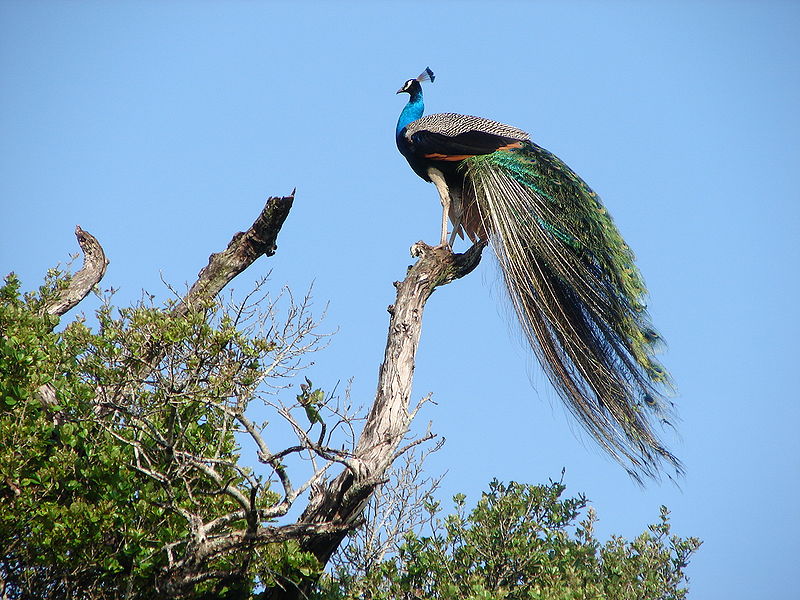 |
| A male peacock in a tree; yes, they CAN fly! |
When a male peacock is in the mood for love, he really knows
how to strut his stuff – he fans out that beautiful fan (called a “train”)
endowed with hundreds of iridescent “eyes”. Then with his train open wide, he
will strut and prance around and sometimes will turn around to display his
tail. And if the female isn’t paying much attention (which is more often than
not), he simply calls to her. Sometimes to woo her into being his mate, a male
peacock will display his tail over some food to get her into a form of
courtship feeding. The peacock’s tail, while not only attractive, can also be
used to direct the sound of a male’s voice toward a female’s ears because of
its satalite dish-like shape. Cool, huh? And if that’s not enough, the peacock
also uses its tail to warn its mates and young that danger is nearby before
flying up to the nearest tree. While both Indian and Green peacocks are
believed to be polygamous, it has been suggested by some that the Green peacock
is actually monogamous.
 |
| A male peacock courting a peahen. Do you think she's impressed? |
 |
| A mother peahen with her chicks |
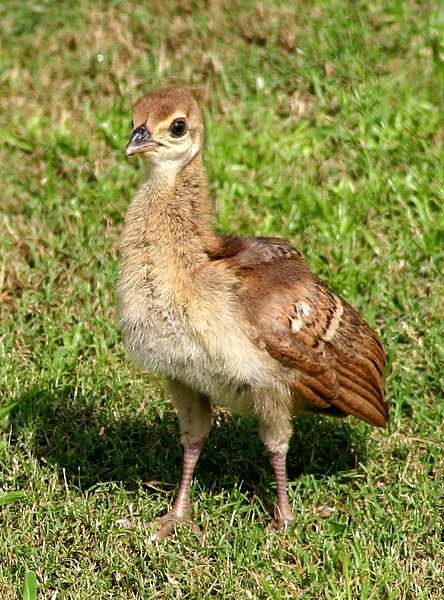 |
| You can hardly tell it now, but yes, this little guy is a peacock chick! |
If peacocks are some of the most beautiful birds, then the
Sage Grouse takes the second place prize for the Weirdest Courtship Displays
(second only to Birds of Paradise, which I’ll talk about later). The Sage
Grouse is the largest grouse in North America and when they are in the mood for
love, they let everybody know about it – with sounds! Male and female Sage
Grouse will gather in groups, called leks, in open clearings and begin to
strut. Like peacocks, they also fan out their tail feathers but they aren’t as
long as those of the peacock. Then to attract females who are nearby, the males
will begin to inflate two large sacks on their chests. These two sacks produce
a sound that sounds like a high-pitched bouncy ball. With every sound, the
sacks bounce. While the sound may sound silly to us, female Sage Grouse can’t
resist a male with a fine singing voice. Only the most successful males get to
mate, and normally there are only two successful males per lek.
.jpg/800px-Sage-Grouse_(7448281486).jpg) |
| A male Sage Grouse, see the two yellow sacks on his chest? |
To see a visual display of the Sage Grouse, click on the
video below:
Some birds get real noisy to attract mates. Others just get
plain showy. When a male Frigatebird wants to attract the love of his life, he
pours his heart out – almost literally! These birds live by the ocean in large
groups and males of the species don’t look like anything special; in fact, they
are almost identical to the females except that females have white chest
feathers and light blue-colored beaks, while the beaks and chest feathers of
males are black. When an attractive female flies by a male sitting in either a
tree or on a cliff, he will inflate a loose patch of skin on the throat. When
inflated, it almost looks like a big red heart! (When I was little, I used to
think the pouch was caused when the Frigatebird swallowed a strawberry!) After
his sweetheart sees a male she likes, she will fly down to him and they start
the courtship process. Frigatebirds are monogamous creatures and are great
parents. Both parents will faithfully care for their single chick for a full
three months until it’s ready to go out on its own. When the next breeding
season comes, Frigatebirds choose a new mate. But I don’t think finding a new
mate is ever a challenge for these birds – what female Frigatebird can resist a
male with a big heart?
 |
| A few male Frigatebirds with their pouches inflated |
 |
| A Frigatebird couple. "What a big pouch you have!" says the female. "The better to woo you with my dear," says the male. |
 |
| A male Frigatebird with a BIG pouch |
Little Huts in the Woods
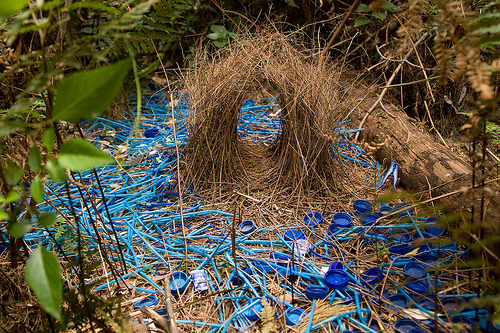 |
| This image came from here |
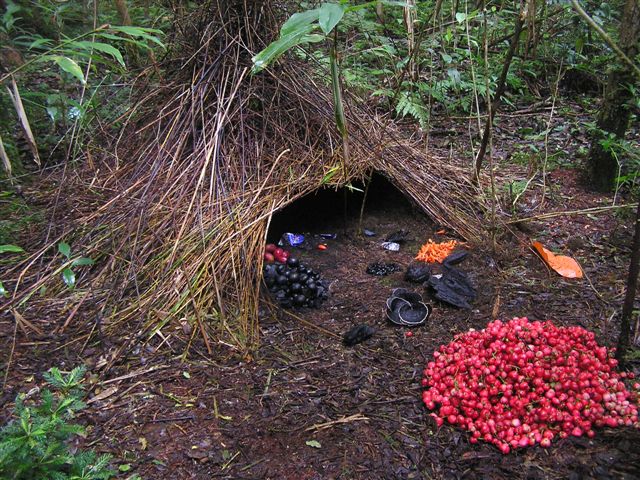 |
| This image came from here |
 |
| This image came from here |
Who do you think made these huts? Animal lovers who wanted to
make a home for some birds? Nope. No human hands touched these huts. In the
Bible, it is made clear that love is not an emotion, but rather an action (and
the sentimental feeling we from someone we love is the result of real love).
You can read an excellent passage about love in 1 Corinthians chapter 13. The
aptly named Bowerbird seems to follow this love-as-action rule (even though
birds don’t feel love like humans do). When the breeding season for bowerbirds
comes around, males get really creative. While the male bowerbird doesn’t look
like a very special bird, looks
aren’t important when they want to attract a mate. Instead, they make a bower
of love. Depending on the species, male bowerbirds will look around their
forest home (in Australia and New Guinea) for certain materials to make a
bower. Today we will focus on two species of bowerbirds: the Satin Bowerbird
(pronounced sat-in) and the Vogelkop
bowerbird (pronounced FOH-gull-kop).
Both species are unique in their own ways. The Vogelkop bowerbird makes one of
the most extravagant bowers. While the bower itself looks no different from its
neighbors’, each bowerbird adds unique arrangements to their own bowerbird.
Some go for a berry-style bower, others for flowers and leaves, and others for
pebbles, shiny beetles or deer dung, and some like the trash we humans leave
behind.
 |
| A Vogelkop Bowerbird observing a bower (this image came from this link) |
Satin bowerbirds have a blue tint in their feathers; perhaps
this is why they’re blue for the color blue. They will put a variety of objects
in and surrounding the bower – as long as their blue! These items can consist
of things in nature such as feathers or berries and on the not-so-natural side,
plastic caps, paperclips and even car keys! (So if you ever go to Australia, be
careful what you put on the ground!) And if that’s not enough, they will even
mash up little plant bits and after mixing it with saliva, “paint” the newly
made mixture on the walls of the inside of the bower! (Guys, don’t try this at
home, human females don’t like a paint made in this way as much as bowerbird
females do) Talk about DIY!
 |
| A male Satin Bowerbird |
 |
| A female Satin Bowerbird |
But in the end, it’s the female bowerbird that chooses which
male she mates with. When a female comes by, a male will sing a little “love
song” to his potential mate and if she likes the sound, she will come down and
inspect the bower. If she likes the bower, she will mate with the hard-working
male and if not, she flies off and continues the search. After mating, the
female flies off to make a nest while the male revises his bower to hopefully
suit the next female that passes by.
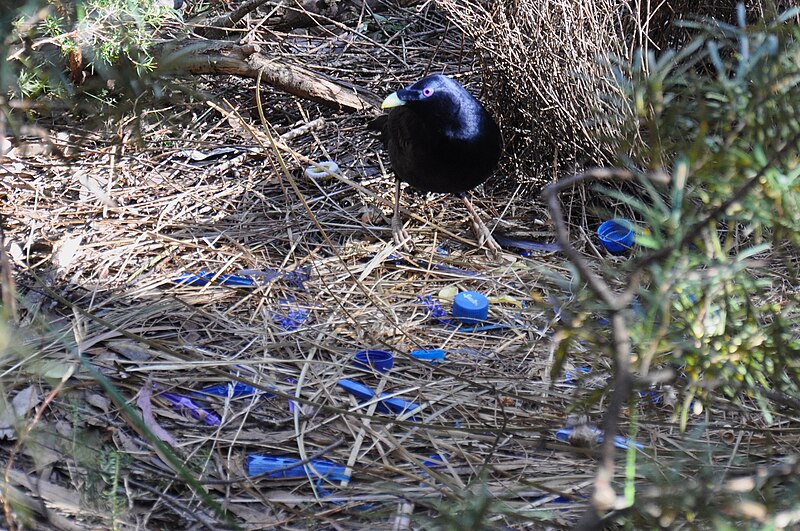 |
| The Satin Bowerbird goes blue for blue! |
Birds-of-Paradise is a group of birds that are perhaps some
of the strangest dancers in the bird world. Males and females are vastly
different from each other – females are drab-colored and feathered while males
have elaborate feathers and feather patterns. There are many species of
Birds-of-Paradise and each species has many different dances they use to
attract a mate. Take the Parotia, nicknamed the “six-plumed birds of paradise” because they have six quills on their
heads. On the males, the ornamental plumage consists of the six head plumes
with black oval-shaped tips, a black collar around the neck, decomposed
feathers that can be spread out around the bird like a ballerina’s skirt. When
they are in the mood for love, they will twirl around and around like a
ballerina in an area where the bird has cleared of leaves. It might also hop
from one foot or bob its head from side to side. Apparently, this funny dance
gets the ladies attention.
 |
| The Six-Plumed Bird of Paradise likes to spin around like a ballerina to attract mates (this image came from here) |
Birds of all shapes and sizes dance around to attract mates
whenever their breeding seasons arrive. Evolutionists will tell you that these
birds evolved another type of animal. Their ideas change as so-called new
“evidence” is found, but for the moment, they believe that birds evolved from
dinosaurs. Now, we have no evidence
for feathered dinosaurs, so where on earth did birds get their beautiful
courtship displays from? (The dinosaurs-to-bird idea is very extensive, so I’ll save this for another day) Evolutionists
have no idea. Even Charles Darwin, the evolutionist of evolutionists said to
Asa Gray that “. . . [the] sight of a
feather in a peacock’s tail, whenever I gaze at it, makes me sick!” Evolutionists
can’t tell us where on earth these amazingly designed birds evolved their
displays from.
However, the Bible has the answer. In the first chapter of
Genesis (Genesis 1:20-22), it says that God created
birds on the fifth day of the week God used to create everything. Dinosaurs
meanwhile were created on the sixth day of the Creation week along with the
other land animals (Genesis 1:24-25). So the reason evolutionists can’t find
what animal evolved into birds that would have given them their displays is
because there isn’t such an animal. God created these birds just as we find
them (not counting the natural selection that occurs within a “Genesis Kind”)
only about 6,000 years ago. And what amazing birds God made!
Before I end my post today, I’d like to bring up a clip from
a Discovery Channel television series that I have watched called Dinosaur Revolution. While true,
dinosaurs didn’t evolve into birds millions of years ago (evolution and the belief in millions of years isn’t true
in the first place!), it doesn’t rule out that dinosaurs didn’t have feathers.
We just don’t have evidence for feathered dinosaurs! If dinosaurs had feathers,
they could have used them to attract mates. So on this Valentine’s Day, lets
watch a dramatic depiction of a male Gigantoraptor
as he tries to win the heart of a female of the same species (I bet you’ve
never seen a dinosaur dancing to Spanish-styled music!). Will she be impressed?
Or will she ditch him for another male? Only one way to find out:
Well, that was an interesting video! I hope you liked it and
I hope you enjoyed this brilliant post about birds and their attempts to woo
the love(s) of their life. I can’t wait till next Thursday, when we’re explore
another amazing wonder of our amazing planet! Bye for now!
PS:
To post a comment (this is highly encouraged), please simply click the
post you wish to comment on, scroll to the bottom of the page and put what you
wish to say or ask in the comment box. Then in the box below the comment box
choose who you’re going to comment as. And then click preview or publish. If
you aren’t signed into Google, you’ll be asked to type in a word and a number
in the space provided. Type the word, put a space and then put the number. Then
your comment is on the blog!
PS 2: Have a puzzling question about animals (including
dinosaurs), myself, my latest book, my stop-motion movies, Creation or etc?
Please post your question as a comment or send me an email at animaladventures@aol.com.
PS 3: What’s the latest scoop? Check it out at SMILEY’S NEWS.
PS 4: Be sure to comment on the latest stop-motion movies
too, this will help me improve them.
No comments:
Post a Comment